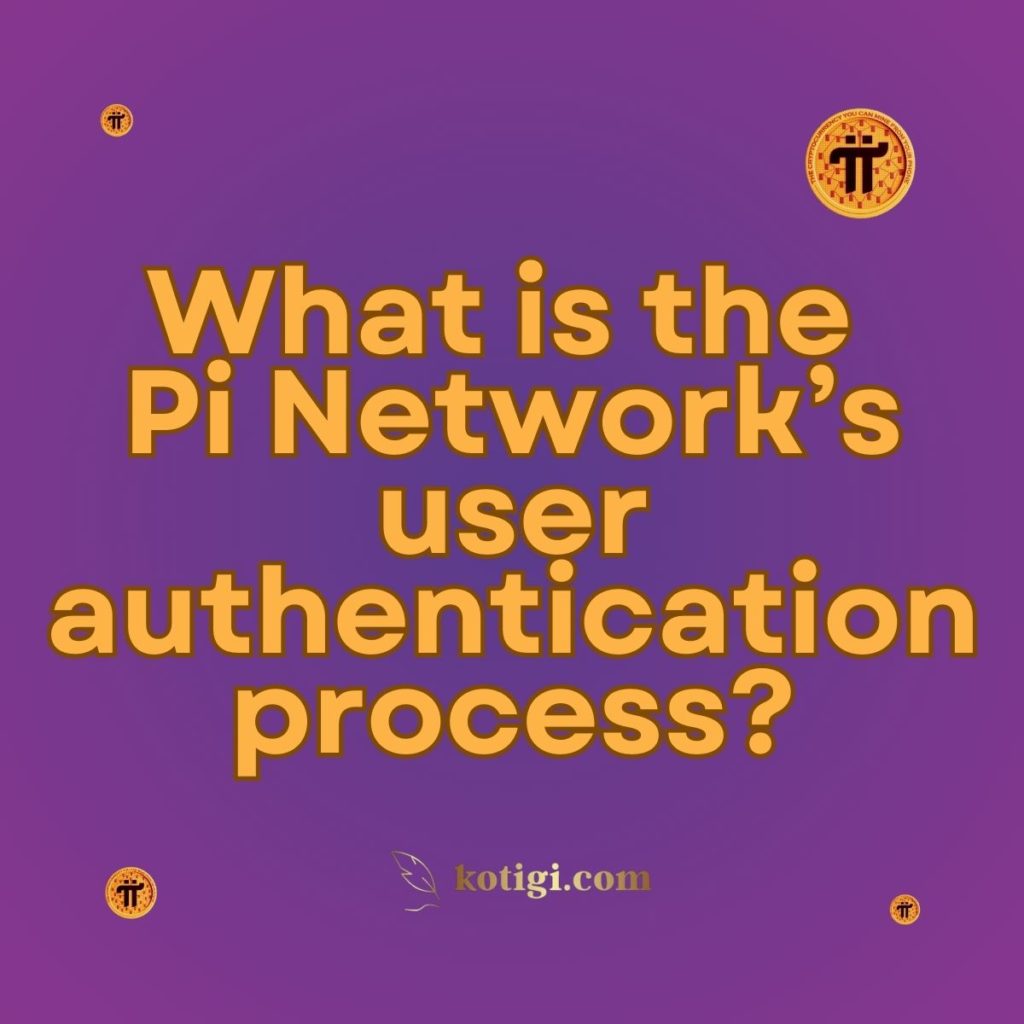
What is the Pi Network’s user authentication process?
The Pi Network employs a robust user authentication process to ensure secure access for its users. This process involves multiple steps, including account creation, phone number verification, and KYC (Know Your Customer) procedures, all designed to enhance security while maintaining user accessibility.
Introduction
User authentication serves as a foundational pillar for any online platform, especially in the cryptocurrency domain where security and trust are paramount. The Pi Network recognizes the critical importance of a secure authentication process to safeguard user accounts and sensitive information while facilitating seamless access to its innovative services. In an era where cyber threats are increasingly sophisticated, ensuring that users can interact with the Pi Network securely is not just a feature but a necessity.
This blog post aims to provide a comprehensive overview of the user authentication process employed by the Pi Network, detailing each step involved, the technologies utilized, and the significance of these measures. By understanding this process, users can engage confidently with the Pi Network and effectively utilize its cryptocurrency, enhancing their overall experience and security.
Importance of User Authentication
User authentication plays a pivotal role in maintaining the integrity and security of any online platform. First and foremost, it acts as a security barrier, protecting user accounts from unauthorized access and potential breaches. In the realm of cryptocurrency, where financial transactions occur, ensuring that only verified users can access accounts is crucial. Additionally, robust authentication processes uphold data integrity, ensuring that user data remains unaltered and secure. Moreover, a trustworthy authentication system fosters user confidence in the platform, encouraging active participation and engagement. When users know their accounts are secure, they are more likely to explore the platform’s features and take advantage of the opportunities it presents.
Overview of the User Authentication Process
The user authentication process in the Pi Network consists of several key steps designed to ensure secure access while maintaining user-friendly experiences. Each stage plays a vital role in creating a secure environment that protects users and their information.
1. Account Creation
The journey begins with account creation, which is the gateway to accessing the Pi Network. Users are required to download the Pi Network app and initiate the registration process by providing essential information such as their name, email address, and a strong password. The choice of a unique username is also an integral part of this step, as it serves to identify users within the network. By requiring a strong password that meets specific security criteria, the Pi Network enhances the initial security measures for new users. This foundational step is crucial, as it sets the stage for subsequent verification processes that further safeguard user accounts.
2. Phone Number Verification
Following account creation, the next critical step is phone number verification, which significantly enhances both security and user identity validation. During this phase, users must submit their mobile phone numbers. In turn, the Pi Network sends a unique verification code to the provided number via SMS. Users are then required to enter this code into the app to complete the verification process. This step not only confirms that the phone number belongs to the user but also adds an additional layer of security by ensuring that unauthorized individuals cannot easily access the account. As mobile phones are personal devices, this verification method is an effective way to establish a direct link between the user and their account.
3. Know Your Customer (KYC) Procedures
To further enhance security and comply with regulatory requirements, the Pi Network implements Know Your Customer (KYC) procedures. KYC is a critical process that involves verifying the identity of users to prevent fraudulent activities within the network. The KYC process typically requires users to upload identification documents, such as government-issued IDs or passports, which serve to verify their identity. Additionally, in some cases, users may be asked to take a selfie to confirm that they match the identification provided. This step is essential not only for security but also for regulatory compliance, as many jurisdictions require platforms dealing with financial transactions to have robust identity verification processes in place. By implementing KYC, the Pi Network not only protects its users but also enhances the credibility of the platform.
4. Two-Factor Authentication (2FA)
To add an extra layer of security, the Pi Network encourages users to enable two-factor authentication (2FA). This method requires users to provide two forms of verification to access their accounts, significantly reducing the risk of unauthorized access. Users can set up 2FA by linking their accounts to an authentication app or opting to receive codes via SMS. Each time users log in, they are prompted to enter a verification code generated by the authentication app or sent to their mobile device. This additional verification step ensures that even if a password is compromised, unauthorized users cannot access the account without the second form of identification.
5. Ongoing Security Monitoring
Beyond the initial authentication steps, the Pi Network employs ongoing security monitoring to detect and respond to potential threats proactively. This monitoring includes anomaly detection, where the network analyzes user activity for any unusual behavior that could indicate unauthorized access or attempts to breach security. Furthermore, the network provides account recovery options for users who may find themselves locked out of their accounts due to compromised credentials or other security incidents. Users have the ability to reset their passwords or reach out to customer support for assistance, ensuring that they can regain access without undue stress.
Technologies Used in User Authentication
The Pi Network leverages various technologies to enhance the user authentication process, ensuring that it is both secure and efficient.
Encryption
Encryption serves as a critical component in safeguarding user data throughout the authentication process. By employing techniques such as password hashing, the Pi Network ensures that user passwords are securely stored, making it exceedingly difficult for unauthorized parties to access them. Additionally, secure communication protocols, such as HTTPS, are utilized to protect data during transmission, ensuring that sensitive information remains confidential as it travels between the user’s device and the network.
Biometric Authentication
As the Pi Network continues to evolve, it may explore the incorporation of biometric authentication methods to bolster security further. Biometric authentication utilizes unique physical characteristics, such as fingerprints or facial recognition, to verify user identity. This method offers a highly secure and convenient way for users to access their accounts, as biometric data is inherently difficult to replicate or steal.
Blockchain Technology
Given the decentralized nature of the Pi Network, it can leverage blockchain technology to enhance secure user authentication. By utilizing blockchain, the network can maintain a transparent and tamper-proof record of user identities and the authentication processes associated with them. This technological approach not only strengthens security but also aligns with the principles of decentralization and user empowerment that are central to the Pi Network’s mission.
Benefits of the Pi Network’s User Authentication Process
The user authentication process in the Pi Network provides several significant benefits that contribute to a secure and trustworthy user experience.
Enhanced Security
The combination of multiple authentication steps—including account creation, phone number verification, KYC procedures, and two-factor authentication—significantly enhances overall account security. Each layer of security builds upon the last, creating a robust system that reduces the risk of unauthorized access and potential breaches.
User Trust
By implementing a comprehensive and effective authentication process, the Pi Network fosters user trust and confidence in the platform. When users feel secure in their interactions, they are more likely to explore the various features and services offered, leading to increased engagement and participation within the community.
Compliance with Regulations
The KYC procedures implemented within the user authentication process ensure that the Pi Network complies with relevant regulations. By actively verifying user identities and preventing fraudulent activities, the platform enhances its reputation and builds trust not only among users but also with regulatory authorities.
Challenges and Considerations in User Authentication
While the user authentication process is designed to be secure and efficient, it also presents certain challenges that the Pi Network must address.
User Experience
One of the primary challenges in implementing a robust authentication process is the potential impact on user experience. While it is essential to prioritize security, it is equally important to ensure that the process remains user-friendly and does not deter users from engaging with the platform. Striking the right balance between security and accessibility is crucial for maintaining user satisfaction.
Privacy Concerns
Collecting personal information during the KYC procedures raises privacy concerns among users. The Pi Network must take proactive measures to ensure that user data is handled securely and in compliance with data protection regulations. Transparency regarding how user data is collected, stored, and utilized is essential for building and maintaining user trust.
Evolving Threat Landscape
As the cybersecurity landscape continues to evolve, the Pi Network must remain vigilant and adapt its authentication processes to address emerging risks and vulnerabilities. Continuous improvement and updates to security measures are vital to ensuring that user accounts remain protected against new and sophisticated threats.
Conclusion
The Pi Network’s user authentication process stands as a vital component of its overarching security framework. By employing a multi-step approach that encompasses account creation, phone number verification, KYC procedures, and two-factor authentication, the network ensures secure access for its users. These measures collectively work to protect user accounts, maintain data integrity, and foster a trusting environment where users can engage with the Pi Network confidently.
As the cryptocurrency landscape continues to grow and evolve, the importance of robust user authentication will only increase. By maintaining a secure and trustworthy environment, the Pi Network not only encourages active participation but also helps to cultivate a thriving community centered around innovation and collaboration.
Key Takeaways
- The Pi Network employs a multi-step user authentication process designed to ensure secure access for its users.
- Key components of the authentication process include account creation, phone number verification, and KYC procedures.
- Two-factor authentication adds an extra layer of security to user accounts, significantly reducing unauthorized access risks.
- The use of encryption and secure communication protocols enhances data protection throughout the authentication process.
- Striking a balance between security and user experience is crucial for maintaining user trust and encouraging platform engagement.





